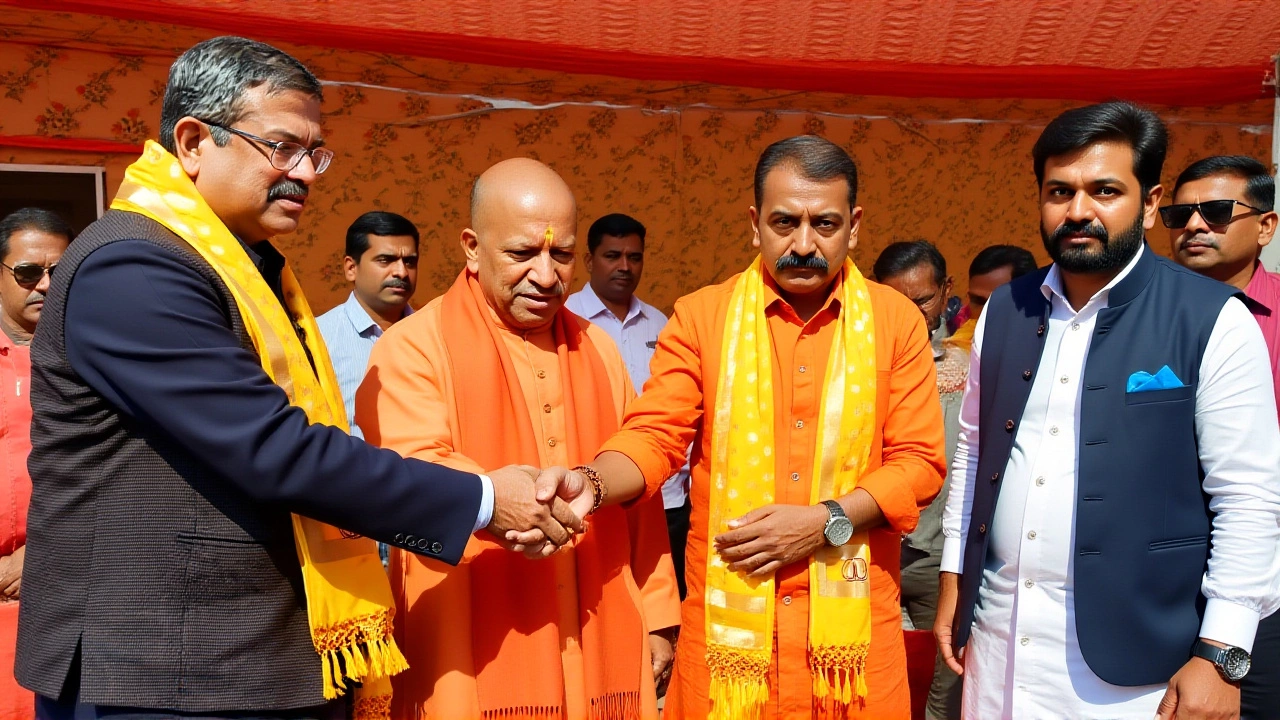Kashi Tamil Sangamam 3.0 Inaugurated in Varanasi with Focus on Sage Agasthya’s Legacy
 Nov, 24 2025
Nov, 24 2025
On a crisp February afternoon in Varanasi, the ancient ghats of the Ganges echoed with chants and classical Tamil verses as Kashi Tamil Sangamam 3.0 was officially launched on February 15, 2025. Led by Dharmendra Pradhan, India’s Union Education Minister, alongside Yogi Adityanath, Chief Minister of Uttar Pradesh, and Dr. L. Murugan, Union Minister of State, the three-day opening ceremony marked the beginning of a 10-day cultural odyssey designed to revive the thousand-year-old spiritual and intellectual ties between Tamil Nadu and Kashi. The event, running until February 24, brings nearly a thousand delegates from across Tamil Nadu — teachers, farmers, artisans, women entrepreneurs, and edutech innovators — into the heart of one of India’s most sacred cities. And this year, the focus isn’t just on exchange. It’s on Sage Agasthya, the legendary figure revered in both the Dravidian and Vedic traditions as the bridge between North and South.
Agasthya: The Forgotten Link Between Two Civilizations
What makes this edition different isn’t just the scale — it’s the soul. While past editions celebrated music, literature, and trade, this one zeroes in on Sage Agasthya, the Vedic sage said to have traveled from the North to the South, spreading Sanskrit, Ayurveda, and Tamil grammar. According to the Ministry of Education, his legacy spans 18 classical Tamil texts, foundational principles of Siddha medicine, and even the creation of the first Tamil alphabet. "Agasthya didn’t just cross rivers," said Dr. Murugan during the inaugural address. "He crossed centuries. He made the Kaveri and the Ganga speak the same language of wisdom." The event includes panel discussions led by Tamil scholars from Madurai and Varanasi-based Vedic historians, who are jointly reconstructing Agasthya’s role in early Indian science — from metallurgy to astronomy.
A Spiritual Journey Beyond Varanasi
The real surprise? This year’s delegates aren’t staying in Varanasi. In a carefully orchestrated spiritual itinerary, participants will travel to Prayagraj to witness the Mahakumbh — the world’s largest religious gathering — and then to Ayodhya to visit the newly inaugurated Ram Mandir. "This isn’t tourism," explained an Education Ministry official. "It’s pilgrimage. For a Tamil farmer from Coimbatore to stand where Rama is believed to have been born, and then return to Varanasi to chant Agasthya’s hymns — that’s not politics. That’s memory returning to the body." Prime Minister Narendra Modi, in a pre-recorded message, underscored this: "The connection between Tamil Nadu and Kashi isn’t historical. It’s ancestral. The Kaveri flows in our blood as much as the Ganga does."

From IIT Madras to the Nation’s Heart
Launched in 2022 as part of the Azadi Ka Amrit Mahotsav celebrations, Kashi Tamil Sangamam began as a modest initiative between IIT Madras and Banaras Hindu University. Back then, fewer than 300 participants attended. Now, with special trains operated by Indian Railways and state-funded accommodations, it’s grown into a national movement. The third edition alone has 1,000 delegates, divided into five thematic groups: education, agriculture, crafts, startups, and spiritual philosophy. "We’re not just inviting people," said Pradhan. "We’re inviting legacies."
Political Echoes and Cultural Resonance
Of course, not everyone sees it as purely cultural. Critics — particularly in Tamil Nadu — have long questioned whether the Sangamam is a soft power play. "Some scholars called it a masterstroke," noted The New Indian Express, "others, a political recalibration." But the participants on the ground don’t see it that way. "I came because my grandmother used to sing Agasthya’s hymns while grinding rice," said R. Meenakshi, a 68-year-old weaver from Thanjavur. "I didn’t know she was connecting me to Varanasi. Now I do." The emotional response has been overwhelming. Teachers from Madurai have already proposed joint curriculum projects with BHU. Farmers from Erode are sharing water conservation techniques used in Tamil Nadu’s arid zones with Uttar Pradesh’s agrarian communities.

What Comes Next?
By February 24, the delegates will return home — but not empty-handed. Each will carry back not just souvenirs, but seedlings: a sapling from the sacred peepal tree near the Kashi Vishwanath Temple, a copy of the newly published "Agasthya Samhita" compiled by scholars from both states, and a digital archive of 120 hours of recorded dialogues between Tamil and Sanskrit scholars. The Ministry has hinted at a fourth edition in 2026, possibly extending the model to connect Kerala with Rajasthan, or Bengal with Gujarat. The real victory? It’s not in the headlines. It’s in the quiet conversations between a Tamil grandmother and a UP schoolboy, both reciting the same verse about the river and the sage.
Frequently Asked Questions
Why is Sage Agasthya central to Kashi Tamil Sangamam 3.0?
Sage Agasthya is uniquely revered in both Tamil and Vedic traditions as the figure who transmitted Sanskrit knowledge to the South and helped shape classical Tamil literature and Siddha medicine. His name appears in ancient Tamil texts like the Tolkāppiyam and in Vedic lore as a disciple of Lord Shiva. By centering this year’s event on him, organizers aim to highlight a shared intellectual heritage that predates modern political boundaries — making unity feel ancient, not imposed.
How is this event different from previous editions?
While earlier editions focused on cultural performances and academic seminars, Kashi Tamil Sangamam 3.0 introduces a spiritual journey to Prayagraj and Ayodhya, linking the event directly to India’s living religious geography. It also deepens participation — nearly 1,000 delegates from Tamil Nadu, compared to 300 in 2022 — and introduces tangible outputs like the Agasthya Samhita and joint curriculum proposals between universities.
Who funds and organizes this event?
The event is spearheaded by the Ministry of Education, Government of India, with logistical support from Indian Railways for transport and collaboration with Banaras Hindu University and IIT Madras. State governments in Uttar Pradesh and Tamil Nadu also contribute funding and infrastructure.
What impact has the event had so far?
Beyond the spectacle, there’s measurable cultural exchange: over 40 joint research proposals between Tamil Nadu and UP institutions, 12 new teacher exchange programs launched, and a surge in Tamil language enrollments at BHU. Even more telling: local businesses in Varanasi report a 300% increase in sales of Tamil textiles and spices during the event — proof that cultural ties are translating into economic ones.
Is this initiative politically motivated?
While political observers have noted the timing — coinciding with upcoming elections and the Ram Mandir’s inauguration — participants and scholars emphasize the authenticity of the cultural revival. The event’s roots trace back to 2022, long before electoral cycles intensified. Many Tamil delegates say they joined because they genuinely wanted to reconnect with a heritage they’d been taught to see as "North Indian," when in fact, it’s theirs too.
Will this model be expanded to other regions?
Yes. Senior officials have confirmed that a pilot program connecting Kerala with Rajasthan is already in planning for 2026, and a similar initiative between Bengal and Gujarat is under review. The goal is to create a national network of "cultural bridges" — not just between states, but between forgotten histories that still live in people’s homes, songs, and rituals.